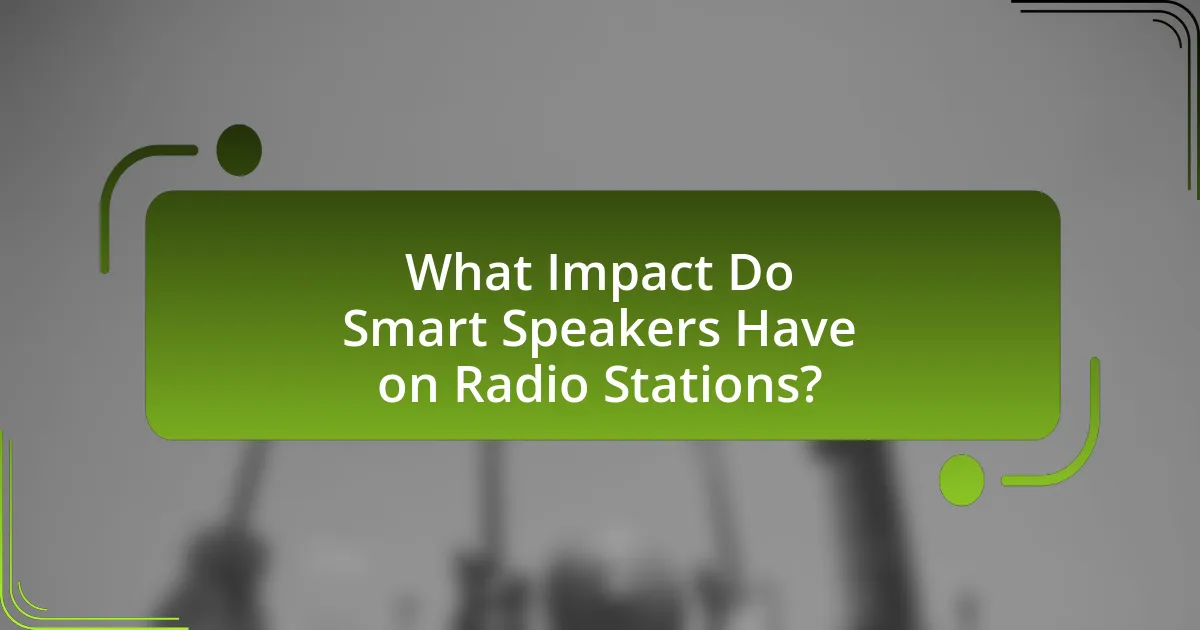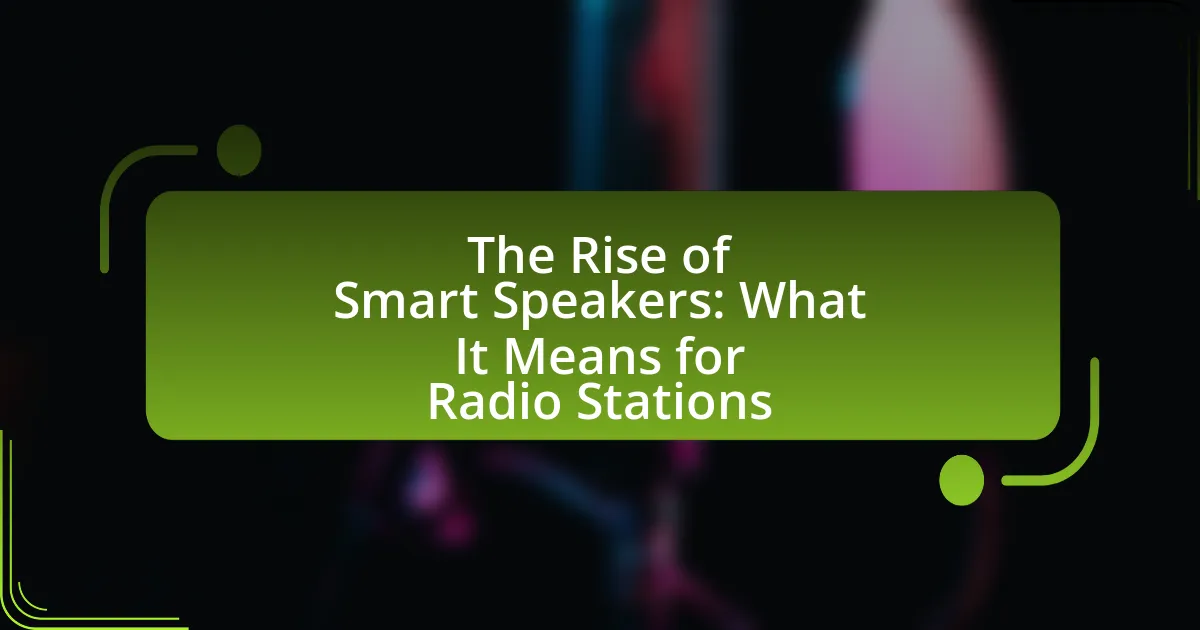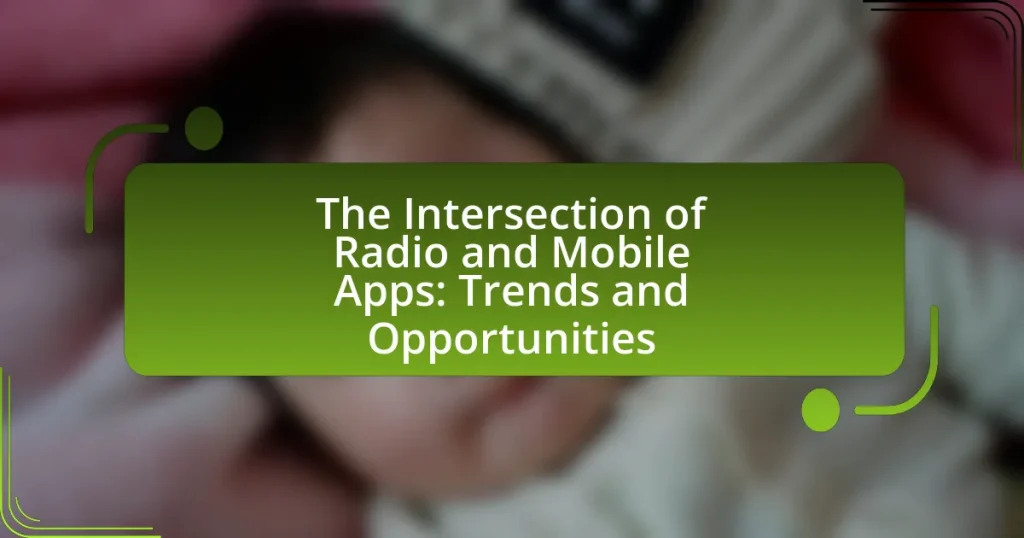Smart speakers are internet-connected devices that utilize voice recognition technology to perform tasks and control smart home devices, with their popularity surging since the launch of the Amazon Echo in 2014. This article explores the evolution of smart speakers, their defining technologies, and the factors driving their increasing adoption, including consumer demand for convenience and the integration of artificial intelligence. It also examines the significant impact of smart speakers on radio stations, highlighting how they enhance audience engagement and accessibility while presenting challenges such as competition from streaming services and the need for technical adaptation. Furthermore, the article discusses future trends in smart speaker technology and radio content delivery, emphasizing the importance of personalization and interactive features for maintaining relevance in a rapidly changing media landscape.

What are Smart Speakers and How Have They Emerged?
Smart speakers are internet-connected devices that use voice recognition technology to perform tasks, provide information, and control smart home devices. They emerged in the early 2010s, with the launch of Amazon Echo in 2014 marking a significant milestone in their popularity. The integration of artificial intelligence, particularly through virtual assistants like Amazon’s Alexa, Google Assistant, and Apple’s Siri, has driven their adoption, leading to a market growth where, as of 2021, over 100 million smart speakers were estimated to be in use in the United States alone. This rapid emergence has transformed how users interact with technology, shifting from traditional interfaces to voice-based commands, thereby influencing various sectors, including radio broadcasting.
What defines a smart speaker?
A smart speaker is a voice-activated device that uses artificial intelligence to perform tasks and provide information through voice commands. These devices typically integrate with virtual assistants, such as Amazon Alexa or Google Assistant, enabling users to control smart home devices, play music, and access information hands-free. The functionality of smart speakers is supported by their ability to connect to the internet and utilize cloud-based services, which enhances their capabilities and user experience.
What technologies enable smart speakers to function?
Smart speakers function through a combination of technologies including voice recognition, natural language processing (NLP), cloud computing, and wireless connectivity. Voice recognition technology allows the device to capture and interpret spoken commands, while NLP enables the understanding and processing of human language, facilitating interaction. Cloud computing provides the necessary computational power and storage for processing requests and accessing vast databases of information. Wireless connectivity, such as Wi-Fi and Bluetooth, allows smart speakers to connect to the internet and other devices, enabling them to stream music, control smart home devices, and access online services. These technologies work together to create a seamless user experience, making smart speakers versatile and functional in various applications.
How have smart speakers evolved over the years?
Smart speakers have evolved significantly since their introduction, transitioning from basic voice-activated devices to sophisticated smart home hubs. Initially, the first smart speaker, the Amazon Echo, launched in 2014, primarily focused on voice recognition and basic tasks like playing music and answering questions. Over the years, advancements in artificial intelligence and natural language processing have enhanced their capabilities, allowing for more complex interactions, integration with various smart home devices, and personalized user experiences. By 2020, smart speakers had become central to smart home ecosystems, with millions of units sold globally, indicating a shift in consumer behavior towards voice-activated technology. This evolution reflects a growing reliance on voice interfaces, with research showing that 55% of households are expected to own a smart speaker by 2022, highlighting their increasing importance in daily life and the media landscape.
Why are smart speakers becoming increasingly popular?
Smart speakers are becoming increasingly popular due to their convenience and functionality in everyday life. These devices allow users to control smart home systems, play music, access information, and perform tasks through voice commands, making them highly user-friendly. According to a report by Statista, the global smart speaker market was valued at approximately $11.2 billion in 2020 and is projected to reach $35.5 billion by 2025, indicating a significant growth trend. This rise in popularity is also driven by advancements in artificial intelligence and voice recognition technology, which enhance user experience and expand the capabilities of smart speakers.
What consumer trends are driving the adoption of smart speakers?
The consumer trends driving the adoption of smart speakers include increasing demand for convenience, the rise of voice-activated technology, and the growing integration of smart home devices. Consumers prioritize hands-free operation and seamless access to information, which smart speakers provide through voice commands. According to a report by Statista, the global smart speaker market is projected to reach 35 million units sold by 2025, indicating a significant shift in consumer preferences towards voice-activated devices. Additionally, the trend of home automation, with 70% of smart speaker users also owning smart home devices, further supports the adoption of smart speakers as central hubs for controlling various technologies.
How do smart speakers enhance user experience compared to traditional devices?
Smart speakers enhance user experience compared to traditional devices by providing hands-free voice control, which allows users to interact with technology more intuitively and conveniently. This capability enables users to perform tasks such as playing music, setting reminders, and controlling smart home devices without needing to physically engage with a screen or remote. According to a report by Voicebot.ai, 55% of households in the U.S. owned a smart speaker by 2022, indicating a significant shift towards voice-activated technology that simplifies user interactions. Additionally, smart speakers often integrate with various services and applications, offering personalized content and recommendations, which further enriches the user experience compared to the more static and manual operation of traditional devices.

What Impact Do Smart Speakers Have on Radio Stations?
Smart speakers significantly impact radio stations by increasing audience accessibility and engagement. With the integration of smart speakers like Amazon Echo and Google Home, listeners can easily access their favorite radio stations through voice commands, leading to a rise in streaming and on-demand listening. According to a 2020 report by Edison Research, 41% of smart speaker owners listen to AM/FM radio through their devices, indicating a shift in how audiences consume radio content. This trend compels radio stations to adapt their strategies, focusing on digital content and interactive features to retain and grow their listener base.
How are radio stations adapting to the rise of smart speakers?
Radio stations are adapting to the rise of smart speakers by enhancing their digital presence and optimizing content for voice-activated platforms. Many stations are developing skills for platforms like Amazon Alexa and Google Assistant, allowing listeners to access live broadcasts and on-demand content through voice commands. According to a report by Edison Research, 40% of smart speaker owners listen to audio content daily, prompting radio stations to prioritize integration with these devices to reach wider audiences. Additionally, stations are leveraging data analytics from smart speakers to understand listener preferences, enabling them to tailor programming and advertising strategies effectively.
What strategies are radio stations implementing to stay relevant?
Radio stations are implementing strategies such as enhancing digital presence, creating on-demand content, and leveraging social media to stay relevant. By developing mobile apps and streaming services, radio stations can reach audiences beyond traditional broadcasting, as evidenced by a 2022 Nielsen report indicating that 60% of listeners engage with radio content via digital platforms. Additionally, radio stations are collaborating with smart speaker technology, allowing users to access their content through voice commands, which aligns with the growing trend of smart speaker adoption, projected to reach 400 million units globally by 2024. These strategies enable radio stations to adapt to changing listener behaviors and preferences, ensuring continued relevance in a competitive media landscape.
How are radio stations utilizing smart speaker technology for broadcasting?
Radio stations are utilizing smart speaker technology for broadcasting by integrating their content into platforms like Amazon Alexa and Google Assistant, allowing listeners to access live streams and on-demand programming through voice commands. This integration enhances audience engagement, as users can easily request specific stations or shows, leading to increased listenership. According to a report by Edison Research, 29% of smart speaker owners listen to radio through their devices, demonstrating the growing trend of radio consumption via smart speakers.
What challenges do radio stations face with smart speaker integration?
Radio stations face several challenges with smart speaker integration, primarily including competition for listener attention, technical compatibility issues, and monetization difficulties. The rise of smart speakers has intensified competition as users have access to a vast array of audio content, including podcasts and streaming services, which can divert listeners away from traditional radio. Additionally, radio stations often encounter technical challenges related to ensuring their content is compatible with various smart speaker platforms, which may require additional resources and expertise. Monetization remains a significant hurdle, as traditional advertising models may not translate effectively to smart speaker environments, leading to uncertainty in revenue generation. These challenges highlight the need for radio stations to adapt their strategies to remain relevant in an evolving audio landscape.
How does competition from streaming services affect radio stations?
Competition from streaming services significantly impacts radio stations by reducing their audience share and advertising revenue. As listeners increasingly turn to platforms like Spotify and Apple Music for personalized content, traditional radio faces declining listener numbers. According to a 2021 Nielsen report, 60% of U.S. adults use streaming services, which has led to a 20% drop in radio listenership over the past decade. This shift forces radio stations to adapt by enhancing their digital presence and offering unique content to retain and attract listeners.
What technical hurdles must radio stations overcome to optimize for smart speakers?
Radio stations must overcome several technical hurdles to optimize for smart speakers, including ensuring compatibility with various voice recognition systems, adapting audio streaming formats, and enhancing metadata delivery. Compatibility is crucial as different smart speakers utilize distinct voice recognition technologies, requiring radio stations to implement solutions that work seamlessly across platforms like Amazon Alexa and Google Assistant. Additionally, radio stations need to adapt their audio streaming formats to meet the requirements of smart speakers, which often favor specific codecs and bitrates for optimal playback quality. Lastly, enhancing metadata delivery is essential for providing listeners with accurate information about the content being played, as smart speakers rely on this data to deliver a richer user experience.

What Future Trends Can We Expect for Smart Speakers and Radio Stations?
Future trends for smart speakers and radio stations include increased integration of artificial intelligence, enhanced personalization of content, and the rise of voice-activated radio services. Smart speakers are evolving to utilize AI algorithms that analyze user preferences, leading to tailored listening experiences. According to a report by eMarketer, over 50% of U.S. households are expected to own smart speakers by 2024, indicating a significant shift in how audiences engage with radio content. Additionally, radio stations are likely to adopt more interactive features, allowing listeners to request songs or access specific content through voice commands, further bridging the gap between traditional radio and digital platforms.
How will advancements in AI influence smart speakers and radio content?
Advancements in AI will significantly enhance the functionality of smart speakers and transform radio content delivery. AI technologies, such as natural language processing and machine learning, enable smart speakers to provide personalized listening experiences by analyzing user preferences and behaviors. For instance, AI can curate playlists and suggest radio stations tailored to individual tastes, improving user engagement. Additionally, AI-driven voice recognition allows for more intuitive interactions, making it easier for users to access content. According to a report by Statista, the global smart speaker market is projected to reach 250 million units by 2024, indicating a growing reliance on these devices for audio content consumption. This shift will compel radio stations to adapt their content strategies, focusing on interactivity and personalization to meet the evolving demands of listeners.
What role will personalization play in the future of radio on smart speakers?
Personalization will play a crucial role in the future of radio on smart speakers by enhancing user engagement and satisfaction. As smart speakers utilize advanced algorithms and user data, they will enable tailored content delivery, allowing listeners to receive recommendations based on their preferences, listening history, and even mood. Research indicates that personalized experiences can increase user retention rates significantly; for instance, a study by McKinsey found that personalization can lead to a 10-30% increase in engagement. This shift towards personalization will not only improve the listener experience but also provide radio stations with valuable insights into audience behavior, enabling them to create more relevant content and advertising strategies.
How might smart speakers change the way audiences engage with radio content?
Smart speakers will significantly change how audiences engage with radio content by enabling hands-free access and personalized listening experiences. With voice commands, users can easily request specific stations, genres, or shows, enhancing convenience and interactivity. According to a 2021 report by Edison Research, 41% of smart speaker owners listen to radio through their devices, indicating a shift in consumption patterns. This technology allows for seamless integration of radio content into daily routines, fostering a more engaged audience that can interact with programming in real-time.
What best practices should radio stations adopt for smart speaker integration?
Radio stations should adopt best practices such as optimizing their audio content for voice search, ensuring seamless streaming capabilities, and engaging listeners through interactive features. Optimizing audio content involves using clear and concise language that aligns with common voice search queries, which enhances discoverability on smart speakers. Seamless streaming capabilities are crucial, as studies show that 70% of users expect uninterrupted playback, making it essential for radio stations to invest in reliable technology. Engaging listeners through interactive features, such as voice commands for requesting songs or accessing station information, can significantly enhance user experience and retention, as evidenced by the growing trend of personalized interactions in digital media.
How can radio stations enhance their content for smart speaker platforms?
Radio stations can enhance their content for smart speaker platforms by optimizing audio quality, creating interactive voice experiences, and providing on-demand content. High audio quality ensures clarity and engagement, which is crucial for listeners using smart speakers. Interactive voice experiences, such as voice-activated requests for specific songs or shows, increase user engagement and satisfaction. Additionally, offering on-demand content, like podcasts or recorded segments, caters to the growing trend of personalized listening, allowing users to access content at their convenience. According to a report by Edison Research, 70% of smart speaker users listen to audio content daily, highlighting the importance of adapting to this platform to capture and retain audience attention.
What marketing strategies can radio stations use to promote their smart speaker presence?
Radio stations can promote their smart speaker presence by leveraging targeted advertising, social media engagement, and partnerships with smart speaker manufacturers. Targeted advertising allows radio stations to reach specific demographics that are likely to use smart speakers, enhancing visibility and listener engagement. Social media engagement can include campaigns that encourage listeners to enable the station’s skill or app on their smart speakers, driving direct interaction. Partnerships with manufacturers like Amazon and Google can facilitate promotional opportunities, such as featuring the station on their platforms or in marketing materials, which can significantly increase listener access and awareness. These strategies are effective as they align with the growing trend of smart speaker usage, which reached over 100 million units sold in the U.S. by 2020, indicating a substantial audience potential for radio stations.



